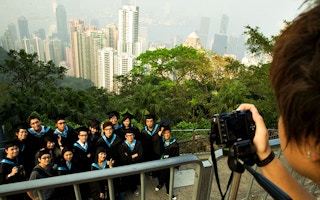Another Earth Hour has come and gone.
To continue reading, subscribe to Eco‑Business.
There's something for everyone. We offer a range of subscription plans.
- Access our stories and receive our Insights Weekly newsletter with the free EB Member plan.
- Unlock unlimited access to our content and archive with EB Circle.
- Publish your content with EB Premium.
Hopefully in this moment of insecurity, members of society have reflected on the state of the climate crisis and are taking the call for “a green reboot after the pandemic” seriously.
Given that universities are a key pillar in society, we would like to set out an agenda whereby current and future leaders cross disciplines to solve environmental problems. There is still considerable work to be done to sketch out how cross-sectoral connections can propel ideas into practice to tackle the climate emergency.
Social scientists should be at the forefront of such efforts. Thinkers such as Fareed Zakaria have correctly pointed to how the social sciences provide a set of critical thinking tools needed in today’s world.
In Hong Kong, former Undersecretary for the Environment Christine Loh has delivered an important message, on various occasions, on how social scientists enrich engineer and scientist-based teams. Consider Project Drawdown’s list of climate change solutions. Two of the top 10 solutions involve modifying the use of refrigerants. Loh rightfully would tell us that, in these instances, social scientists can simplify and communicate technical solutions to the broader public.
Several other cases buttress this point. For one, societies need clear information on the progress of battery storage and its potential applications since many citizens are pinning their hopes on this energy transformation without much accompanying knowledge. Conversely, many citizens are uncertain whether rooftop solar is a major opportunity or not. University researchers should be staking out their positions and sharing evidence to shed light on these issues for the general public.
Equal members
Loh’s model has its limits since it primarily views social scientists as the communications arm for STEM-discipline concepts and discoveries. Social scientists should instead become equal members or even leaders of teams so that they can bring their problem-solving skills, creativity, and critical thinking to bear. Linkages between biology and the social sciences have yielded important insights and are illustrative of the potential.
Hong Kong, as an example, excels in STEM disciplines but a close look at some of the most prestigious Hong Kong research funding, particularly the Collaborative Research Fund and the Theme-Based Research Scheme, presents an impenetrable list of technical projects that, while important in their own right, seem insufficiently weighted to the greatest challenge of our time—realising carbon neutrality—and largely absent the participation of social scientists. Grants related to big questions concerning environmental futures should, by their nature, insist on diverse team memberships.
What are some of the fields ripe for interdisciplinary exchange?
First, while change is definitely afoot, business graduates still need to improve their capacity to place finance and economics in environmental terms. At the same time, members of the environmental sector need to become more conversant in business models and principles to make the case to funders and wider society for structural reform.
Second, some—such as former top Microsoft executive Craig Mundie, in author Thomas Friedman’s book, Hot, Flat, and Crowded—have opined that it is up to engineers to solve the climate crisis. While engineering is central to a carbon neutral future, problem-solving engineers could benefit from engagement with natural and social scientists because of the critical questions that these scholars pose, as well as their capacity to plan for how solutions might be implemented in society.
Universities are rightfully being held to account for their commitment to climate action. In this spirit, here are our priorities for reform:
- Encourage employers to accept students from a range of disciplines and move away from discipline-restricted internships
- Boost the profile and funding for environmental entrepreneurship and social enterprises
- Increase funding for scholars to solve environmental problems in interdisciplinary teams
- Widen the number of double major programmes at universities and promote these opportunities in secondary schools
- Cross-list more faculty members between departments, including those working on environmental issues
- Revise curricula to incorporate more team-based problem solving
- Further promote and expand environmental studies programmes
- Form new networks in society by designing interdisciplinary initiatives outside the classroom. One such initiative is the upcoming Asian Sustainability Case Study Challenge, funded by the Global Consortium for Sustainability Outcomes (GCSO), a global network of universities, research institutes and corporate sponsors that are interested in co-developing and testing potential solutions to urgent sustainability problems. For the challenge, students from universities and secondary schools around the world will work towards solutions on green buildings and ocean plastics.
Today’s youth give us some hope for the environmental challenges facing society. It is no longer the case that individuals must wait until they are middle-aged and holding senior roles in an organisation to make an impact. Young people are taking on leadership roles to address the climate emergency and the mainstream financial sector no longer draws a disproportionate share of talented graduating students.
Impact investing and new media are revealing examples. Impact investing is an emergent form of finance where capital is allocated to projects that promise a positive environmental impact. The enthusiasm of young people in this space is palpable and young environmental entrepreneurs are the beneficiaries of decisions taken by investment teams.
Young people are also making their mark in media. For example, Hong Kong’s role in the global flow of e-waste was exposed by a young journalist who drew on multiple disciplines and advanced technology to break this story. Even better would be national and Asian regional media hiring graduates from interdisciplinary programmes to write accessible stories on discoveries in the sciences.
These examples herald a future where reinvigorated universities shape young minds while, at the same time, feed off the passion of youth who seek to further social change.
Justin Robertson is an Associate Professor and Danny Marks is an Assistant Professor in the Department of Asian and International Studies of City University of Hong Kong. Both are active researchers and teachers on environmental change, urban sustainability and the global economy with a particular focus on Asia.












